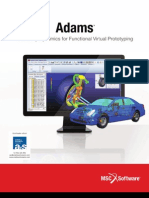Ic Engine Crank Adams Multibody Simulation Tutorial Download
Abstract:
Various components of IC Engine 3.1 Connecting Rod Connecting rod is the key component of an IC engine. It undergoes cyclic loadings under different running speed of the vehicle. Gaba Peeyush 2 et. Al., has performed stress analysis of connecting rod and discussed guidelines for its finite element simulation. IC engine piston crank assembly. The motion is simulated and various parameters are plotted. The simulation is interactive. This tutorial is a complete step-by-step guide,easy to follow and grasp. You can improvise by learning this tutorial first and then do design of your own. Solved4u - Tutorials adams engine tutorial and numerous books.
Crankshaft Figure 2: Multibody model of the cranktrain implemented in ADAMS. 3.RigidMultibodyModelling The first step in the modelling process was the definition of a multirigid-body model of the system. Starting from 3D CAD models of the components, these were imported into the multibody environment and assembled by means of kinematic joints.
A virtual prototype model of S195 diesel engine was established by using CAD, finite element analysis based on virtual prototype technology and dynamics theory of flexible multibody systems to study the kinetic discipline of the crank-rod mechanism,vibration of cylinder block caused by inertia force and the balance problem of inertia force.The rigid body and flexible body simulation were compared.The interaction force between components could be determined by flexible multibody dynamics analysis of the crankshaft system under the real working condition. The simulation results are accordant with those in true working state of S195 diesel engine. This research provides a feasible advanced method for design and development of diesel engine.
Ic Engine Crank Adams Multibody Simulation Tutorial Java
Ic Engine Crank Adams Multibody Simulation Tutorial C++


[1] Zissimos P. Mourelatos: A Crankshaft System Model for Structural Dynamic Analysis of Internal Combustion Engines. Computers & Structures, Vol. 79 (2001), p.2009-(2027).
DOI: 10.1016/s0045-7949(01)00119-5
[2] Z.H. Wang J.B. Li: Simulation technology for dynamic performance of a racing motorcycle engine based on virtual prototyping. Journal of Vibration and Shock. Vol. 27 (2008), pp.150-154. (In Chinese).
[3] X.G. Ma,X.M. Yao: Multi-body dynamics simulation for a crankshaft system based on virtual prototype technology. Journal of Vibration and Shock. Vol. 27 (2008), pp.155-157. (In Chinese).
[4] J.R. Zheng: Introduction and improvement of virtual prototyping technology (China Machine Press, China, 2002).
[5] Guagliano M., Terranova A., Vergani L: Theoretical and Experimental Study of the Stress Concentration Factor in Diesel Engine Crankshafts.ASME J. Mech. Des., Vol. 115 (1993), pp.47-52.
DOI: 10.1115/1.2919323
[6] D.M. Zheng, Noel C. Perkins: An Efficient Multibody Dynamics Model for Internal Combustion Engine Systems. Multibody System Dynamics. Vol. 10 (2003), pp.363-391.

DOI: 10.1023/a:1026276619456
[7] Heath A.R., McNamara P.M.: Crankshaft Stress Analysis-Combination of Finite Element and Classical Analysis Techniques. ASME J. Eng. for Gas Turbines and Power, Vol. 112 (1990), pp.268-275.
DOI: 10.1115/1.2906491
[8] H.Y. Isaac Du: Simulation of Flexible Rotating Crankshaft Engine Block and Hydrodynamic Bearings for a V6 Engine. SAE. Vol. 108 (1999), pp.1852-1860.
DOI: 10.4271/1999-01-1752
